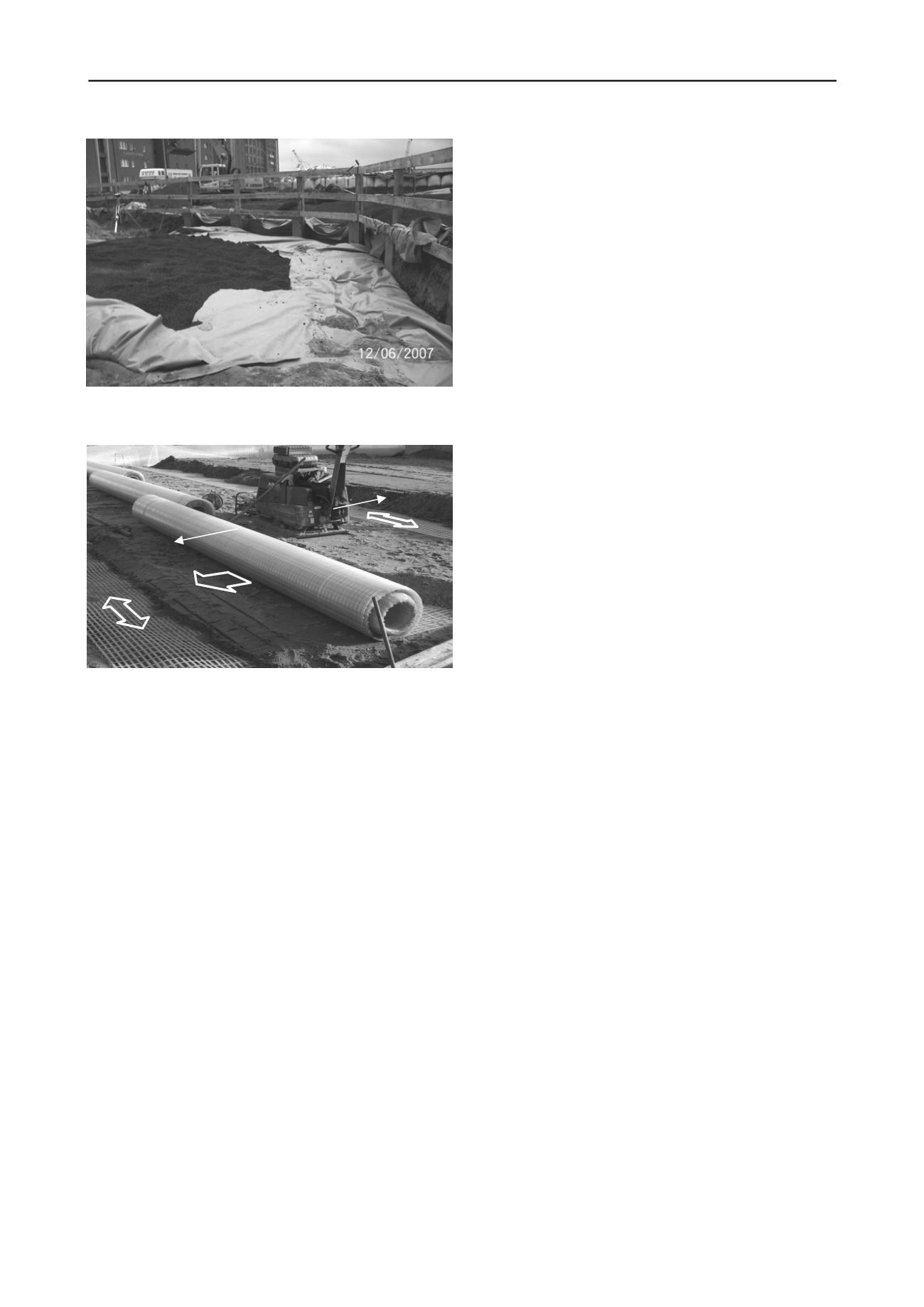
2632
Proceedings of the 18
th
International Conference on Soil Mechanics and Geotechnical Engineering, Paris 2013
Figure 5: Placing of expanded clay
Figure 6: Laying of the geogrid
4. CONCLUDING REMARKS
Three quite different methods of soil improvement techniques
were used in the area of Hongkongstrasse. The prime objective of
the soil improvement is, in all cases, the reduction of subsequent
settlements in order to guarantee the serviceability of the
trafficked areas under operating conditions.
The decisive factors in the choice of construction method are
the local conditions, the time constraints, and the economic
conditions applicable to the section being planned or built.
Settlement pre-emption with vertical drains and a sand pre-load
requires a relatively long lead time. Significant associated
settlements must be expected in the immediate vicinity; in the case
of existing buildings or services these will usually have to be
classified as unacceptable. On the other hand, the foundation soil
remains more or less undisturbed in its stratification and
composition, and is free of construction elements.
In contrast to this, soil improvement using expanded clay, i.e. a
lightweight aggregate, involves only very small additional
settlements. This method is therefore advantageous mainly at the
interface with existing structures, and with existing roads. Because
of the cohesionless nature and the low compressive strength of
expanded clay, difficulties can be experienced later if services and
anchorage layers are installed, or reconstruction work carried out.
With its columns and the geogrid layers, the pile-supported
base-course method contains the most construction components.
Depending on the construction process of the columns, this
method can be used even close to existing structures. Particularly
in cases of large fill depths – and these are typical of the
HafenCity – services can be constructed at a later date without
problems. And the structure can be continued without a break in
the adjoining construction section; building over existing elements
such as pipes is not a problem. Perforation of the geogrid-
reinforced base, e.g. by anchor layers, is possible in principle.
The sandfill material can be assumed to incur the lowest cost as
regards the pure construction costs of the structure. Under the
conditions applying at the HafenCity, the pile-supported, geogrid-
reinforced method is usually somewhat cheaper to construct than
an expanded-clay fill layer. Absolute costs must be ascertained
taking into account project-specific reconstruction, protection and
follow-on measures. In addition to the cost aspect, the time
flexibility for individual measures, and their technical feasibility
under local conditions, are decisive criteria.
The authors wish to thank HafenCity Hamburg, Eggers
Umwelttechnik GmbH and Tilman Kaden Landschaftsbau, Bad
Segeberg for their support and permission for publication.
Thanks are due to NAUE GmbH & Co. KG for providing the
instrumented geogrids and technical support.
5. REFERENCES
EBGEO – Empfehlungen für den Entwurf und die Berechnung von
Erdkörpern mit Bewehrungseinlagen aus Geokunststoffen.
(Recommendations for Design and Analysis of Earth Structures using
Geosynthetic Reinforcements) 2. Auflage 2010. Hrsg. DGGT. Verlag
Ernst & Sohn, Berlin.
Axis of road
Kempfert, H.-G., Stadel, M. &Zaeske, D. (1997): Berechnung geokunst-
stoffbewehrter Tragschichten über Pfahlelementen. Bau-technik 74
(1997), Heft 12
Vollmert, L., Kahl, M., Giegerich, G. & Meyer, N. (2007): In-situ
verification of an extended calculation method for geogrid reinforced
load distribution platforms on piled foundations. XIV European
Conference on Soil Mechanics and Geotechnical Engineering
(ECSMGE), Madrid, September 2007
Weihrauch, S., Oehrlein, Vollmert, L. (2010): Baugrund-
verbesserungsmaßnahmen in der HafenCity Hamburg am Beispiel des
Stellvertreterprojektes
Hongkongstraße.
Vortragsband
zur
31. Baugrundtagung der DGGT, München, 3. – 6. November 2010


